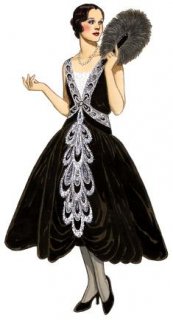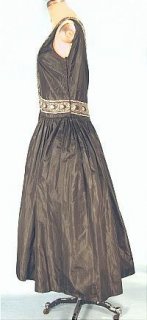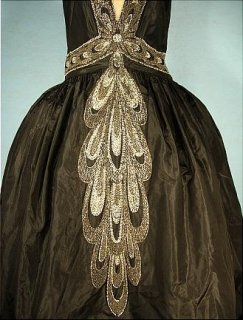Whitelinen
Active Member
- Joined
- Dec 21, 2005
- Messages
- 5,760
- Reaction score
- 1
Thank you, thank you, thank you for this thread!I love Lanvin, past and present 



This is the iconic dress from the era by Lanvin. Tom Tierney used the dress to showcase in his paperdoll book. And a similar Lanvin is shown in the Kyoto Costume Institute Fashion History book, which describes the dress as "significant". Black silk tissue taffeta with rhinestones, bugle beads and seed pearls in amazing deco design. Measures: 42" bust, 40" waist, 50" long from shoulder to hem. There are pinholes in the skirt (seen when held up to light), but looks nearly perfect without the light. The front ecru net panel at bust has some minor light staining, and just a small percentage of the seed pearls are missing. Any other beads missing are not worth even mentioning. There is no underpinning or lining. I shaped in the robe de style shape with tissue under. Pannier undergarment is necessary for the correct look. This dress can easily be the highlight of your 1920's clothing collection.








Dress
1922-1923
Black silk taffeta trimmed with machine-embroidered silk chenille and cream silk georgette bows and bands
Throughout the 1920s Jeanne Lanvin (1867-1946) excelled in the creation of ultra-feminine dresses with fitted bodices and long, full skirts, known as robes de style, of which this evening dress is an example. The black fine silk taffeta dress with boat neckline, and small, capped half-sleeves fastens with poppers down the left side. A pair of immense fern-like fronds are machine-embroidered in furry cream chenille on the skirt, and the cream colour is echoed in floating bands caught in silk georgette bows at the right sleeve and left waist.
Coat
summer 1929
Black crêpe and silk chiffon
This knee-length afternoon coat, designed by Jeanne Lanvin, is made of black silk chiffon, to which squares of black wool crepe have been applied arranged in a radial pattern from the yoke, increasing in size towards the hem. The binding cuffs and double band collar are of the same material. The coat is cut with a slight flare from shoulder to hem and there is no fastening. The sleeves are long, slightly full and tapering to the wrist.
This coat is a significant example of the meeting between fashion and modernity: the geometrical forms, assembled according to the 'collage' technique, refer to the strong influence of abstract art on fashion during the 1920s. Black became an increasingly fashionable colour for elegant evening wear and was popularised by Coco Chanel in the mid-1920s.
Evening dress
winter 1935
Satin, machine-sewn
This dress, designed by Jeanne Lanvin, is made of purple satin, cut on the bias of the fabric. It is sleeveless and has a low cut rectangular neckline. The back of the dress is cut into a point, attached to the back of the collar and showing two triangles of naked flesh. A huge collar based on a rectangular form is made of triangles and squares. The collar is covered with narrow parallel rows of stitching which reinforce the fabric and allow the collar to keep its shape. Lanvin broke the long line of the dress by attaching two ribbons, equally covered with stitches, at either sides of the waist. The ribbons, once fastened, emphasise the waist, a new and important feature of 1930s fashion. By using one single, very strong colour in this dress, Lanvin achieved the simple, yet sculptural look of the 'classical' fashion of the period.
Satin became popular in the 1920s when it was increasingly used for costumes in the silent cinema for its evocative character and the way it attracted the light. In Hollywood cinema, satin became the emblematic fabric of the 1930s Art Deco evening dresses and was mostly used in monochrome colours.
Cape
Winter 1935
Silk velvet hand sewn and hand rushed
This evening cape designed by Jeanne Lanvin (1864-1946) is a good example of her consummate knowledge of fabrics and characteristic love of textures. During the 1930s, fashion designers created boleros, and short capes to emphasise the length and fluid shapes of the evening gowns. The waist-length evening cape is made of purple silk velvet ruched to achieve the effect of Astrakhan fur. It has a wide rounded square falling collar fastening at the neck with a silvered button. The ruching, moulded on chiffon, is vertical over the shoulder, and horizontal on the collar and on the rest of the garment. It is lined with satin matching that of the dress.
This cape shows a very avant-garde design for the period. Its architectural shape, the off-the-neck gigantic collar and the use of huge buttons herald, almost 20 years before its time, a style developed by Balenciaga in the mid 1950s.



Dress, ca. 1924
House of Lanvin (French, founded 1890), Couture House; Jeanne Lanvin (French, 1867–1946),
Designer French
silk, wool; a) L. at center back: 42 ¼ in. (107.3 cm).
Gift of Mrs. Carter Marshall Braxton, 1980 (1980.92.1a–c)
Seeking in both the new cylindrical silhouettes and in her characteristic robes de style to adorn flat planes with new designs associated with Art Deco, Lanvin developed a repertoire of motifs at once modern and decorative. Black cutouts are stitched by hand to a contrasting white dress. The design is even further integrated into the dress by the stitching's being hidden under the edge of the appliqué, thus making it appear a pieced rather than an applied patterning.
Robe de style, 1924–25
Jeanne Lanvin (French, 1867–1946)
Ivory and black silk taffeta trimmed with pink and black silk velvet rosettes
Gift of Mrs. W. R. Grace, 1956 (C.I.56.49.9)
Robe de style, 1924–25
Jeanne Lanvin (French, 1867–1946)
Ivory and black silk taffeta trimmed with pink and black silk velvet rosettes
Gift of Mrs. William B. Given Jr., 1979 (1979.122.1)
High art as well as haute couture have often been erroneously associated with the sovereign disposition. But haute couture has also been conditioned on the relationship between couture ideas and the will of the client. A client seeking a demure profile might ask for a particular décolletage treatment, while another might demand an alternative. A designer would allow variation only in modules, but a couture garment often becomes a synergy of client and couturier.
Evening ensemble, ca. 1934
Jeanne Lanvin (French, 1867–1946)
Black silk taffeta with metal plaques
Gift of Miriam W. Coletti, 1993 (1993.423.1a,b)
Lanvin's evening bolero resembles the tubular construction of the kimono and its sleeves. However, Lanvin modifies her simulation by radically cropping the kimono's parts. The three-diamond shape (the diamonds are superimposed on one another) composed of metal plaques is an allusion to the mon, a Japanese clan insignia.

Philippe Chancel/Musée des Arts Décoratifs, Paris
The bathroom of Jeanne Lanvin’s apartment, designed by Armand Albert Rateau in the 1920’s, on display at the Musée des Arts Décoratifs.
Two weeks from today , the Musée des Arts Décoratifs, with its 10 period rooms, will reopen in Paris after a 10-year...
...One of the most anticipated spaces is a private suite, comprising the boudoir, bedroom and bathroom of Jeanne Lanvin (1867-1946), the founder of France’s oldest couture house and creator of perfumes like Arpège and My Sin.
Lanvin opened her couture business in 1889. In 1920 she expanded into interior design, creating Lanvin Decoration, and hired the Paris Art Deco designer Armand Albert Rateau to run it. It was Mr. Rateau who decorated her grand town house on Rue Barbet-de-Jouy, in the Seventh District, which she bought for herself and her daughter Marguerite. The suite is from this house, and was donated by a Lanvin relative.
The bathroom shows how much Rateau’s style was influenced by Pompeii. It has marble-covered walls, a floor of geometric mosaics in black and beige marble, a hand-carved Italian marble sink, and bronze fixtures that were given a patina to make them look ancient. It is a bit cryptlike and devoid of any decoration apart from a few bottles of Arpège, which Rateau also designed.
At a time when pieces of Rateau bronze furniture are selling for nearly $1 million, there should be great interest in the Lanvin period rooms.
 even though I never gave Lanvin much credit before, it's steadily becoming one of the labels I look out for the most, and this thread only gives me more reason to do so
even though I never gave Lanvin much credit before, it's steadily becoming one of the labels I look out for the most, and this thread only gives me more reason to do so 
